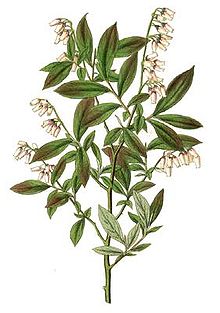Vaccinium virgatum: Difference between revisions
m r2.7.1) (Robot: Adding ru:Голубика Эши |
No edit summary |
||
| Line 12: | Line 12: | ||
|binomial = ''Vaccinium virgatum'' |
|binomial = ''Vaccinium virgatum'' |
||
|binomial_authority = [[William Aiton|Aiton]] |
|binomial_authority = [[William Aiton|Aiton]] |
||
|binomial = ''Vaccinium ashei'' |
|||
|binomial_authority = [[Reade]] |
|||
|}} |
|}} |
||
'''Rabbiteye Blueberry''' ('''''Vaccinium virgatum''''', also known as ''V. ashei'') is a species of [[blueberry]] native to the [[Southeastern United States|Southeastern]] [[United States]], from [[North Carolina]] south to [[Florida]] and west to [[Texas]]. |
'''Rabbiteye Blueberry''' ('''''Vaccinium virgatum''''', also known as ''V. ashei'') is a species of [[blueberry]] native to the [[Southeastern United States|Southeastern]] [[United States]], from [[North Carolina]] south to [[Florida]] and west to [[Texas]]. |
||
==Description== |
==Description== |
||
Revision as of 19:34, 9 January 2012
| Rabbiteye Blueberry | |
|---|---|

| |
| Scientific classification | |
| Kingdom: | |
| (unranked): | |
| (unranked): | |
| (unranked): | |
| Order: | |
| Family: | |
| Genus: | |
| Species: | V. virgatum
|
| Binomial name | |
| Vaccinium ashei | |
Rabbiteye Blueberry (Vaccinium virgatum, also known as V. ashei) is a species of blueberry native to the Southeastern United States, from North Carolina south to Florida and west to Texas.
Description
Vaccinium virgatum is a deciduous shrub growing to 3 to 6 feet tall and with up to a 3 foot spread.[1] The leaves are spirally arranged, oblanceolate to narrow elliptic, 3 inches long and start out red-bronze in the spring only to develop into a dark-green[1]. The flowers are white, bell-shaped, 5 mm long. The fruit is a berry 5 mm diameter, dark blue to black, bloomed pale blue-gray by a thin wax coating.
Characteristics
Rabbiteye blueberries are self infertile and must have two or more varieties to pollenize each other. Honeybees are inefficient pollinators, and carpenter bees frequently cut the corollas to rob nectar without pollinating the flowers. Rabbiteyes do best when pollinated by buzz pollination by bees, such as the native southeastern blueberry bee, Habropoda laboriosa.
Cultivation
It grows best on acid soil and is subject to few pests and diseases. This blueberry is not self-fruitful, so two compatible varieties should be planted next to each other to maintain growth and fruiting. If maintained with mulching, the berries can handle temperatures as low as 10 degrees Fahrenheit. The plants can mature to the height of 3 to 6 feet with a width of up to 3 feet. The plant has little insect or disease problems, however birds and squirrels are prone to eating them.[1]
It is grown as an ornamental plant for its fall colors, typically bright orange or red, and for it's edible properties.[1]
Uses
Vaccinium ashei Berries may have pain killing properties (antinociceptive effects).[2] The berries are edible and are used as sauces and syrups, and for breads, muffins, pancakes, and pies.[1]
References
- ^ a b c d e Bruce Asakawa; Sharon Asakawa (3 September 2001). California Gardener's Guide. Cool Springs Press. p. 44-45. ISBN 978-1-930604-47-6. Retrieved 25 November 2011.
- ^ Maria Rosana Ramirez, Leandra Guterres, Odila E. Dickel, Micheli R. de Castro, Amelia T. Henriques, Márcia M. de Souza, Daniela Martí Barros "Preliminary Studies on the Antinociceptive Activity of Vaccinium ashei Berry in Experimental Animal Models." Journal of Medicinal Food. April 2010: 336-342
External links
- Rabbiteye blueberry culture from Alabama Extension
- The hepatitis healing power of blueberry leaves
- Info on Rabbiteye Blueberry Varieties
